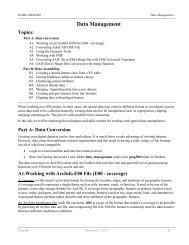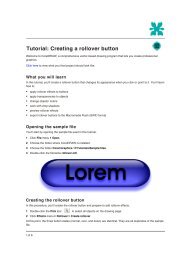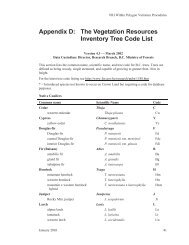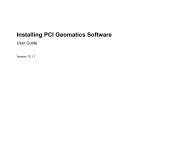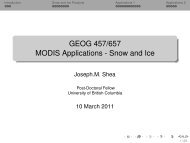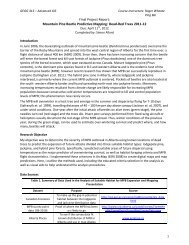Understanding Map Projections
Understanding Map Projections
Understanding Map Projections
You also want an ePaper? Increase the reach of your titles
YUMPU automatically turns print PDFs into web optimized ePapers that Google loves.
Unless explicitly stated, it’s impossible to tell from<br />
the parameters alone which convention is being<br />
used. If you use the wrong method, your results can<br />
return inaccurate coordinates. The only way to<br />
determine how the parameters are defined is by<br />
checking a control point whose coordinates are<br />
known in the two systems.<br />
Molodensky method<br />
The Molodensky method converts directly between<br />
two geographic coordinate systems without actually<br />
converting to an X,Y,Z system. The Molodensky<br />
method requires three shifts (∆X,∆Y,∆Z) and the<br />
differences between the semimajor axes (∆a) and the<br />
flattenings (∆f) of the two spheroids. The Projection<br />
Engine automatically calculates the spheroid<br />
differences according to the datums involved.<br />
( M + h)<br />
∆ϕ<br />
= − sin ϕ cos λ∆X<br />
− sin ϕ sin λ∆Y<br />
2<br />
e sin ϕ cosϕ<br />
+ cosϕ∆Z<br />
+<br />
2 2 1/<br />
(1 − e sin ϕ)<br />
+ sin ϕ cosϕ(<br />
M<br />
a b<br />
+ N ) ∆f<br />
b a<br />
( N + h) cosϕ<br />
∆λ<br />
= − sin λ∆X<br />
+ cos λ∆Y<br />
2<br />
∆a<br />
M and N are the meridional and prime vertical radii<br />
of curvature, respectively, at a given latitude. The<br />
equations for M and N are:<br />
a(1<br />
− e )<br />
M =<br />
2 2<br />
(1 − e sin ϕ)<br />
a<br />
N =<br />
2 2<br />
( 1 − e sin ϕ)<br />
2<br />
3/ 2<br />
1/ 2<br />
You solve for ∆λ and ∆ϕ. The amounts are added<br />
automatically by the Projection Engine.<br />
Abridged Molodensky method<br />
The Abridged Molodensky method is a simplified<br />
version of the Molodensky method. The equations<br />
are:<br />
M ∆ϕ<br />
= − sin ϕ cos λ∆X<br />
− sin ϕ sin λ∆Y<br />
+ cosϕ∆Z<br />
+ ( a∆f<br />
+ f∆a)<br />
⋅ 2sin ϕ cosϕ<br />
N cosϕ<br />
∆λ<br />
= − sin λ∆X<br />
+ cos λ∆Y<br />
∆h<br />
= cosϕ<br />
cos λ∆X<br />
+ cosϕ<br />
sin λ ∆Y<br />
+ sin ϕ∆Z<br />
+ ( a∆f<br />
2<br />
+ f∆a) sin<br />
ϕ −∆a<br />
∆h<br />
= cosϕ<br />
cos λ ∆X<br />
+ cosϕ<br />
sin λ ∆Y<br />
+ sin ϕ ∆Z<br />
− (1 − e<br />
a(1<br />
− f )<br />
+<br />
2 2<br />
(1 − e sin ϕ)<br />
1/ 2<br />
2<br />
2<br />
sin ϕ)<br />
2<br />
1/ 2<br />
sin ϕ ∆f<br />
∆a<br />
h<br />
ϕ<br />
λ<br />
a<br />
b<br />
f<br />
e<br />
ellipsoid height (meters)<br />
latitude<br />
longitude<br />
semimajor axis of the spheroid (meters)<br />
semiminor axis of the spheroid (meters)<br />
flattening of the spheroid<br />
eccentricity of the spheroid<br />
26 • <strong>Understanding</strong> <strong>Map</strong> <strong>Projections</strong>




